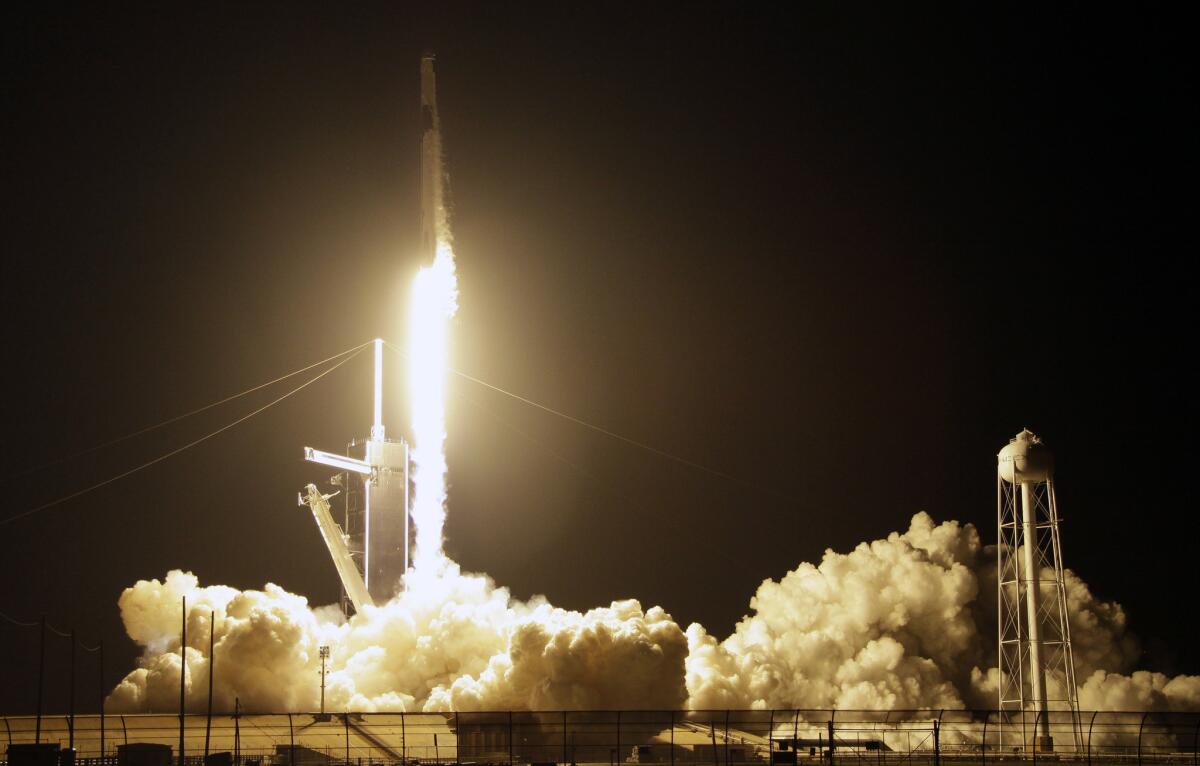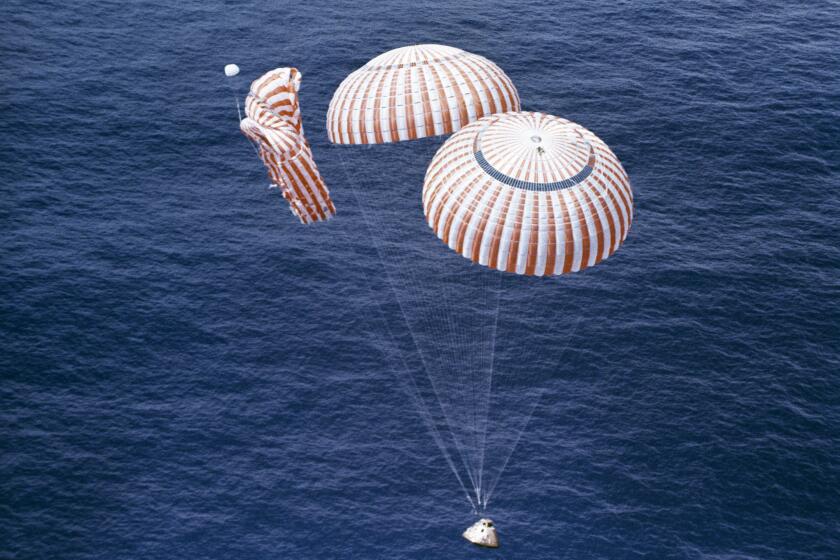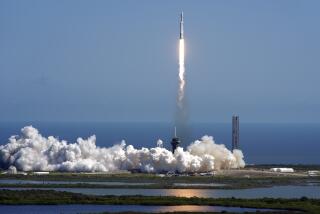Before SpaceX launches astronauts, it has to ace this last big test

- Share via
Elon Musk founded SpaceX with the intention of one day sending humans to space.
Eighteen years later, the Hawthorne company has launched commercial satellites, astronaut supplies, sensitive government payloads and even a Tesla Roadster. But not humans. Yet.
Only one major test now stands between SpaceX and its long-awaited plan to ferry NASA astronauts to and from the International Space Station. On Saturday morning, the company is scheduled to test the in-flight abort capabilities of its Crew Dragon spacecraft. Shortly after launch, the capsule’s escape system should activate, blasting the spacecraft away from the rocket as it would in an emergency. Then, the capsule is supposed to float down under parachutes to the Atlantic Ocean.
No humans will be aboard, though the test is intended to prove that the capsule can keep astronauts safe in a dire situation.
“You can’t fully test a launch system until you get it completely off the ground,” said Laura Forczyk, owner of consulting firm Astralytical. The test will be “a big proof that yes, commercial vehicles can do it.”
Since the beginning of the U.S. space program, NASA has owned the crafts that carried humans to space. Contractors built the Saturn V rockets that propelled humans to the moon and the space shuttles that carried crews to the space station, but they did so with explicit direction from NASA.
SpaceX’s Crew Dragon capsule is different.
In 2014, SpaceX and Boeing Co. were awarded contracts worth a total of $6.8 billion to each build a capsule to take NASA astronauts to the space station. Under the terms of the contract, the companies own the spacecraft they develop; NASA simply pays for the astronauts’ rides, as well as part of the capsule development. The capsules must still be certified by NASA to ensure they meet safety requirements, but there is more room for the companies to innovate on the design and engineering.
The public-private partnership has not always been a smooth ride. Both SpaceX and Boeing are years behind schedule — the original goal was to launch NASA astronauts by 2017 — and each has faced setbacks during development.
In April, a SpaceX Crew Dragon capsule exploded on the ground during a test, just a month after that craft flew to the space station and back without a crew. After a three-month investigation, SpaceX found that a leaky valve in the capsule’s propulsion system probably led to its destruction. The company said it has since replaced those valves with more resilient parts.
In 2018, a propellant leak caused a fire that damaged one of Boeing’s test capsules. And during a test flight last month, a faulty timer on Boeing’s Starliner astronaut capsule prevented the uncrewed craft from reaching the correct orbit to dock with the space station, cutting short the planned mission. NASA and Boeing have launched a joint investigation into what went wrong.
In addition to developmental challenges, the program has also faced federal budget cuts, which slowed funding and progress. That has all contributed to looming uncertainty about U.S. access to the space station.
The U.S. has paid Russia to transport its astronauts to space since 2011, when the shuttle was retired. As SpaceX and Boeing’s capsule programs experienced delay after delay, the U.S. has had to buy additional seats on the Russian Soyuz spacecraft.
The nation’s booking of Soyuz seats extends through October. If neither SpaceX nor Boeing has a capsule ready for regular service by then, the U.S. may have to buy more seats from Russia, which would require congressional approval.
NASA and the two companies have emphasized that ensuring the safety of the new spacecraft comes first.
“We need to triple-, quadruple-check everything and make sure, ‘Is there anything we’ve overlooked?’ ” Musk, who is SpaceX’s chief executive, told reporters in October. “And if there is, we will delay the launch without hesitation and make those changes.”
Musk also emphasized that tests could reveal additional problems, which would take time to fix.
Saturday’s test, scheduled for 8 a.m. Eastern time at Kennedy Space Center in Florida, will initially mimic a typical launch for SpaceX’s Falcon 9 rocket and the Crew Dragon capsule. But instead of letting the craft head to space, SpaceX plans to trigger the capsule’s launch escape system about a minute and a half after liftoff, forcing the shutdown of the rocket’s first-stage engines and the activation of the capsule’s SuperDraco thrusters. Those thrusters should jet the crew capsule away from the rocket before shutting down and letting the capsule coast. Then, a second set of thrusters should power up to right the capsule before its parachutes deploy and slow the craft for its splashdown in the Atlantic Ocean. The whole test should last about 10 minutes.
After separation from the capsule, the rocket will break up on its own over the ocean from the aerodynamic forces it will experience during the test, SpaceX said. Since it will be fully fueled, the rocket’s destruction could look like a fireball in the sky, Benji Reed, SpaceX’s director of crew mission management, told reporters Friday. The booster to be used for Saturday’s flight is a reused one: It launched three missions in 2018.
How well the capsule’s parachutes perform is a particular area of interest. Both SpaceX and Boeing have struggled with parachute development. In addition to doing Saturday’s abort test and analyzing the resulting data, SpaceX will need to run more tests of its parachute system before it’s ready for a crewed test flight.
“We’ve got work to do, but honestly, getting this [abort] test behind us is a huge milestone,” Kathy Lueders, manager of NASA’s Commercial Crew Program, said Friday.
Even SpaceX and Boeing, which have accomplished great engineering feats, are still grappling with the tech.
Such launch abort capabilities are used on rare occasions. In 2018, a U.S. astronaut and a Russian cosmonaut en route to the space station reported a problem with the rocket booster shortly after liftoff and used the Soyuz’s launch escape system to make an emergency landing. The crew touched down safely in Kazakhstan.
The moments after liftoff are a time of extreme stress on a spacecraft, so the ability to abort and whisk away the astronauts lowers the risks and could save their lives, said Lori Garver, who served as NASA’s deputy administrator from 2009 to 2013. “It’s a great thing to be able to do.”
NASA and SpaceX are also using the in-flight abort test as an opportunity to run through what astronauts and ground crews will do when the capsule flies humans. On Friday, NASA astronauts Bob Behnken and Doug Hurley, who are slated to fly on the first crewed test, practiced suiting up, going to the launch pad and heading to the capsule, in part to see how long those steps would take. Ground crew members and mission control operators also rehearsed their tasks.
“We want to test like we fly, and we want to practice like we fly,” Reed said.
More to Read
Inside the business of entertainment
The Wide Shot brings you news, analysis and insights on everything from streaming wars to production — and what it all means for the future.
You may occasionally receive promotional content from the Los Angeles Times.












